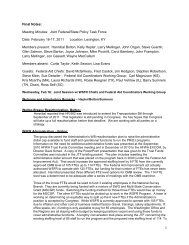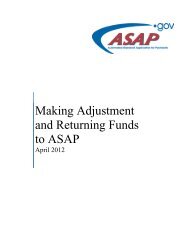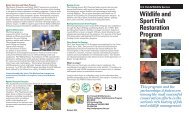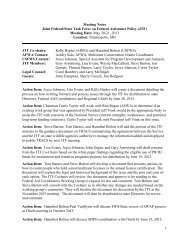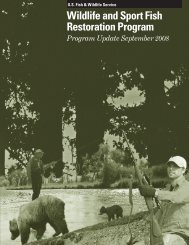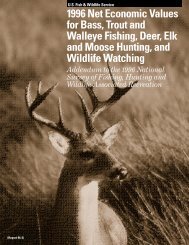Financial Returns To Industry From The Federal Aid - Wildlife and ...
Financial Returns To Industry From The Federal Aid - Wildlife and ...
Financial Returns To Industry From The Federal Aid - Wildlife and ...
Create successful ePaper yourself
Turn your PDF publications into a flip-book with our unique Google optimized e-Paper software.
EXECUTIVE SUMMARY<br />
Since 1932, firearms <strong>and</strong> ammunition manufacturers have paid a federal excise on the<br />
products they manufacture.<br />
However, until 1937 these funds were deposited in the general treasury of the United<br />
States <strong>and</strong> did not directly benefit manufacturers. In that year, sportsmen <strong>and</strong><br />
businesses teamed with conservation-minded policy makers to redirect these existing<br />
excise taxes to the new Pittman-Robertson <strong>Wildlife</strong> Restoration Program, which has<br />
continued ever since.<br />
<strong>The</strong> concept of redirecting these taxes to benefit wildlife populations was simple: By<br />
investing in improvements to wildlife populations <strong>and</strong> public access, more people would<br />
go hunting <strong>and</strong> the sales of items that generated this tax would increase.<br />
This partnership between the hunting <strong>and</strong> shooting-sports industries, hunters, <strong>and</strong> state<br />
<strong>and</strong> federal wildlife agencies has restored many wildlife populations to unimaginable<br />
numbers <strong>and</strong> provides an incredible array of hunting opportunities, as documented in<br />
this text.<br />
<strong>To</strong>day, there are more than twice as many hunters than there were in 1937. Purchases<br />
of tax related items by hunters have increased by nearly 45% in constant dollars since<br />
1970.<br />
Fueling this growth, in part, has been the reliable funding that was provided by the<br />
excise tax. In 2009, excise taxes on hunting equipment totaled $484,765,728 from<br />
sales of firearms, archery equipment <strong>and</strong> ammunition. <strong>The</strong>se taxes are distributed to<br />
the states to invest in projects that improve wildlife populations, provide improved<br />
access to the huntable l<strong>and</strong>s, or to develop shooting-sports facilities -- in short, to<br />
increase the number of recreational hunting <strong>and</strong> shooting opportunities.<br />
However, as with any capital investment that a business makes, companies want to<br />
know the quantitative return received from this investment. <strong>To</strong> help answer this, an<br />
analysis was conducted at the national <strong>and</strong> local levels using actual data on excise<br />
taxes invested <strong>and</strong> hunter purchases of excise-tax related products. This analysis<br />
revealed the following long-term <strong>and</strong> short-term insights about the returns from the<br />
excise taxes paid by firearm <strong>and</strong> ammunition manufacturers:<br />
Long Term Benefits:<br />
In 1937, 11 states had no open seasons for deer <strong>and</strong> three others had<br />
only local seasons. Virtually all of the remaining states had far more restrictive<br />
seasons than enjoyed today. Examples of hunting then compared to now<br />
include:<br />
Missouri's deer season was only three days long, <strong>and</strong> only 108 deer<br />
were harvested. In 2009, hunters in the Show Me state hunted deer for




